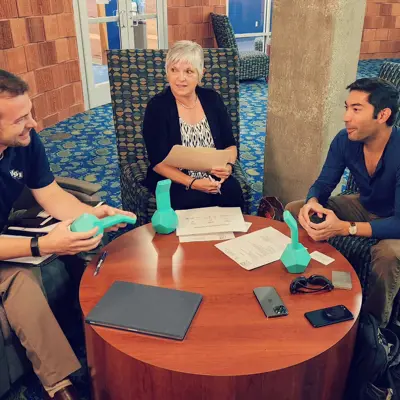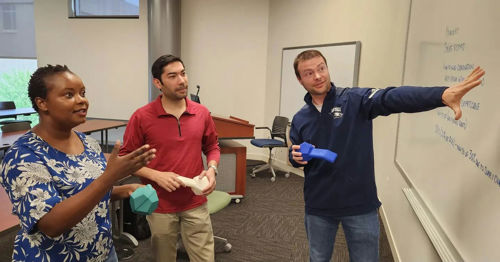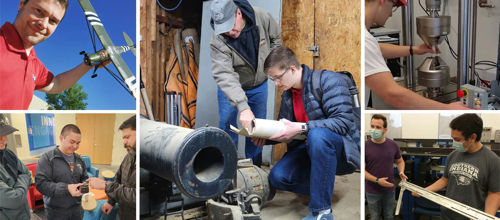
USI’s Center for Applied Research partners with doctor on stroke recovery device
Collaboration highlights USI resources and student experiences
November 28, 2023
Since 2020, Steven Stump, Director of USI’s Center for Applied Research (CAR), has assisted Dr. Luke Barr, Director of Neurology at Deaconess Health Systems, in creating and marketing his invention, the Polyform - 1H. Barr came up with the Polyform-1H when he realized thousands of people who experience stroke or other types of brain and spinal injury normally don’t regain all their hand function back.
“It’s something that kept popping up in my head. Why aren’t their hands getting better,” Barr said. “I decided to try to do something about it, and this is what I ultimately came up with, the Polyform-1H.”
Poly means many, 1 means first and “H” means hand. The Polyform-1H is a device with a textured knob and handle. Users keep one hand open on the knob and the other gripped on the handle. The open hand grips the knob and opens again while the other hand turns the knob, and the process repeats. Barr said the design helps tease the brain into thinking the process for both hands is similar but not the same, which helps keep the brain engaged better. Most hand-rehabilitation devices require one hand to be used at a time, but Barr wanted to create a device that uses both hands to coordinate with each other in a more natural way.
“A lot of studies coming out now indicate when you use your hands in a coordinated fashion like that, it increases your brain’s ability to create new connections in a process we call neuroplasticity,” he said.
 Barr already had a design idea in mind for the Polyform-1H and started contacting different schools in the area to get some 3D design work done. He came across CAR almost randomly but was impressed by their responsiveness and transparentness; his relationship with CAR blossomed right away.
Barr already had a design idea in mind for the Polyform-1H and started contacting different schools in the area to get some 3D design work done. He came across CAR almost randomly but was impressed by their responsiveness and transparentness; his relationship with CAR blossomed right away.
For the past three years, CAR has helped Barr with his product in numerous ways. From the initial design and production phase to prototyping and how to mass produce his product, CAR aided the Polyform-1H in becoming a reality. The center has continued to support Barr in his entrepreneurial path by helping him create an overall marketing and branding awareness strategy, as well as a business plan, and continuing to answer any questions he may have along the way. Currently, CAR is helping him launch a digital marketing campaign.
“The actual advertising has been done through a third-party vendor, but they’ve (CAR) been instrumental and helped me get all my ducks in a row to figure out exactly what my strategy is going to be and how to find a partner to execute that strategy,” he said.
USI students Leo Osborne ‘24 and Aven Kimmell ‘22 helped work on the product design for the Polyform - 1H, and Hope Burdette, Brianna Beard and Maliah White all helped create the logo design for Barr’s venture, Plasticity Neurorehabilitation.
Osborne, a manufacturing engineering major, is now a student technician at CAR. He was approached by the center at the end of his freshman year to help design the Polyform-1H. He helped create 3D printed models of the product through a program called SolidWorks by iterating the design and creating different sizes and densities of the product, as well as helping with package design. Recently, he’s helped work on some different-sized models for the market and a double-ended version of the Polyform-1H to see how it compares to the original.
“This project helped me practice with the software I need in some of my engineering classes,” Osborne said. “That’s what is so great about the Center for Applied Research, it helps fill in the gaps and teaches me things I would not learn in the classroom. This project also gave me the opportunity to learn how to meet with clients and brainstorm their ideas with them to come up with a solution to their problem. Meeting with clients and getting experience with those types of conversations is the most important thing I learned doing this project.”
White, a senior graphic design and public relations and advertising major, got involved in creating the logo with two of her classmates through Chuck Armstrong Assistant Professor of Graphic Design. The group created the logo together from start to finish over the span of a month or two of meeting with Barr. They began by gathering information from Barr and had a lot of creative freedom since there were no prior brand guidelines to follow. Together, they were able to collaborate and build ideas off each other to perfect their design and hand it off.
“I was a sophomore when I participated in this, so this was one of my first times creating work for a client outside the classroom,” White said. “For graphic designers in the career force, most work involves clients and creating work for others. It's also a field where your portfolio and experience matter. This opportunity put me ahead of my peers by giving me professional, applied experience I can take with me as I enter the workforce after graduation.”
Stump said students can get involved with CAR projects through senior design classes, but he prefers hiring them as student workers so they can work on projects and get paid while doing it. Currently, his team of student employees consists of eight engineering majors and two computer science majors. Typically, he hires students based on faculty recommendations when he’s looking for a specific skill set for a project.
“I don’t always have the right kind of projects to employ students from every major, I wish I did,” Stump said. “But I highly recommend it because there are several things you get out of it.”
Stump said student workers at CAR get paid $15 per hour, which makes the job competitive in that respect. The work is also directly related to a student's major, and they get a hands-on application of work in their field. They also have access to a flexible schedule, and they get to put their CAR experience on their resume.
“We’re able to offer good pay, great flexibility and something relevant to your major,” Stump said. “I call that an absolute win.”
 Barr described the process of working with students and faculty as “very seamless.”
Barr described the process of working with students and faculty as “very seamless.”
“That’s mostly thanks to Steven Stump,” he said. “He gets all the ducks in the row. I’m very busy in my day-to-day job and having somebody that’s on the ball like that for so many different things has been invaluable to me. That’s been my experience not only at USI but also in a couple of the local firms I’ve used in Evansville for other aspects of this project.
“When you’ve got that seamlessness where you can state your goals and your needs, and somebody else brings it together for you and you’ve just got to show up and do that thing, you can accomplish an hour of work in 30 minutes,” Barr said. “This isn’t a waste of time. The fact that you’re saving that amount of time and you’re having that seamlessness, that efficiency and ongoing contact is very difficult to find.”
Barr thinks CAR will continue to be instrumental to him in terms of jumpstarting projects so he can have a tangible project to take to additional levels of expertise.
“I feel that as long as I’m in this area, CAR will be playing a significant role in my business endeavors,” he said. “There’s a tremendous amount of expertise here. It’s extraordinary.” Barr has already sent a few people to CAR for business consultations, and he said they have been “extremely fruitful” for those individuals.
“I think the capabilities here at USI can be utilized by anybody for anything,” he said. “All of their resources are very robust. I don’t know what the entrepreneurial spirit is throughout the entire town, but there’s a strong capability here at USI that is going to become more and more prominent through a depth of more and more aspects of science, engineering, marketing, business, etc.”
Barr is grateful for the resources at USI and for the many opportunities to connect with people across different departments to make it happen. He believes CAR is not only beneficial in making the student body successful but also in innovating a better culture for the city of Evansville.
“Obviously, you get a first-class education. And these are very bright people, driven people and talented people,” he said. “When you’re generating that kind of culture, it’s going to be great for the city long term.”
Stump encourages students, faculty or those in the community to learn more about what the Center for Applied Research can offer.
“At the end of the day, the Center for Applied Research is just taking the knowledge, equipment, labs and capabilities we have on this campus and asking how we can find a practical application that benefits someone in the community,” he said. “We’re here to help connect the dots, bring people together and create solutions that help these organizations outside USI while offering practical experience to our faculty and students.”